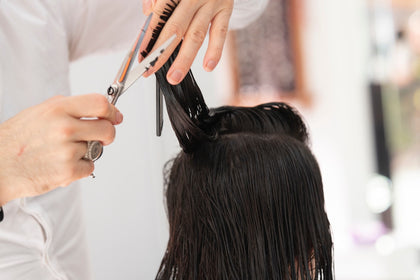If you're trying to grow out your hair and have been avoiding trips to the salon, you might want to re-think your style strategy!
Turns out, when you can't remember your last haircut, missing a salon appointment might actually be doing more harm than good. Read on to learn how often to trim hair for maximum growth, according a hairstyling pro. Plus, discover which clean, natural products you should be using in tandem with trims to encourage thicker-looking hair.
What the Experts Recommend
While it might sound counterintuitive, regular haircuts can actually help — not hinder — healthier hair and could even encourage growth. According to an expert, heading to the salon for a scheduled trim will help save time in the long run, potentially preventing further damage that can require even more maintenance.
"Trimming hair helps with the appearance of healthier, shinier hair," said Florida-based hairstylist Barbara Eisenberg. "When the ends are split and dried out, it makes the hair look thinner, drier and unhealthy. Damaged hair is much harder to maintain, so regular trims are very important to keep hair looking its best."
Read: What You Can Do to Fix Damaged Hair
Cutting Cues: How Often Should You Trim Your Hair?
Get right to the root of healthy hair by derailing damage before it starts. Read this guide before you get your next haircut. Follow these expert-approved cues to determine how often you should actually be getting a trim that supports the unique needs of your hair texture and type.
Cutting Cue #1: Know When to Go
According to Eisenberg, your hair will tell you when it's ready for a trim. "Hair doesn’t grow from the ends, it grows from the roots," she said. "However, when you begin to notice the ends breaking, splitting and looking drier than the rest of your hair, it’s time for a trim."
Cutting Cue #2: Break Free From Breakage
Split ends aren't doing your hair any favors and in most cases, they actually make your hair look worse. "By cutting the dead, split ends off, your hair will look much healthier. Everyone’s hair is different based on factors like diet, lifestyle and genetics," explained Eisenberg. "Some people can go much longer in-between trims to keep hair looking healthy, whereas others will need to go more frequently."
Read More: How to Prevent Split Ends
Cutting Cue #3: Factor in How Fast Your Hair Grows
Your hair grows on its own timeline, so just be patient if you're waiting for yours to get longer. "[Hair growth] is different for each person," said Eisenberg. "Factors include diet, genetics and overall lifestyle."
Cutting Cue #4: Rethink Your Product Routine
The next step: Reworking your hair wellness care routine to complement your cut!
"There are also many proven and effective products on the market to help your hair grow in conjunction with regular trims," said Eisenberg. "These include topical oils such as an argan oil, ingestibles such as vitamins, hair serums and more."
One to try: GRO Hair Serum. Apply the leave-in serum morning or night and style it as desired immediately following application. The natural, nourishing serum is powered by plant-based phyto-active clean ingredients which encourage the appearance of enhanced hair density while supporting visibly thicker, fuller-looking hair.
Cutting Cue #5: Add Supplements to Your Hair Care Routine
Supplement your diet — and haircut schedule — by adding GRO Biotin Gummies into the mix. The vegan gummies make it possible to get a daily dose of delicious key nutrients no matter where you are. The gummies are packed with good-for-you key nutrients including 16,666% of your daily value of biotin (5000 mcg) along with folic acid, vitamins A, B-5, -6, -12, C and E, as well as zinc and other key minerals to neutralize free radicals, supporting and nourishing the scalp and hair.
"Your diet is very important for hair health. Consuming healthy fatty acids and proteins (and an overall balanced diet) is also important for optimal hair growth," said Eisenberg. " If you are taking any medications, talk to your doctor about the potential side effects, including the impact to your hair."
Cutting Cue #6: Length Matters
Next, it's time to assess your tresses. Routine trims can benefit all hair lengths, whether you have short hair, medium-length hair or long hair. However, those with bangs, layers and/or shorter styles (think pixie cut or bob) will likely need to get snipped more often than those with one-length or long hairstyles who can potentially go for eight weeks or longer between trims.
Cutting Cue #7: Space Out Trims Based on Texture and Type
Every hair texture and type can experience split ends and dryness. These make the hair appear visibly dull and unhealthy, Eisenberg explains, meaning it's probably time for a trim.
"Those with short hair will need more frequent trims than those with mid-length or long hair," said Eisenberg. "If growth is the goal, I recommend going slightly longer in-between trims. However, once you start to see dryness, breakage or a split end or two, it’s time to see your stylist."
If you're trying to grow out medium or thick hair that's generally healthy, a good rule of thumb is to trim half an inch every 10-12 weeks, which translates to once per season.
A style with layers or bangs might require more frequent trims, ranging anywhere from two weeks to eight weeks.
Wondering when to cut curly hair, kinky hair, wavy hair or chemically treated hair? If you have hair that's been chemically treated or if you regularly heat style your hair with curling irons or dryers, there's a good chance you have a rough hair shaft and broken, split ends. In this case, it's a good idea to see a stylist to customize a plan. Even taking half an inch off can do wonders for damaged, broken ends on any textured or curly hair type.
#include-related-slider#
Cutting Cue #8: Create a Curated Plan With Your Stylist
If you have any concerns or are noticing more split ends and damaged hair than normal, that's another indicator that it's time to make the cut. Head to a trusted hair pro to help create a maintenance and care routine that addresses your needs and suits your lifestyle.
"Talk to your stylist about your overall hair goals," said Eisenberg. "They can help you come up with a plan to achieve the length and look you desire."
Read: What's Your Hair Texture and Type? Here's How to Find Out
Refresh Your Hair the Natural Way
Growing out your hair doesn't mean you should skip the salon, nor does it mean compromising your self-care or hair health. Instead, opt to tailor your scheduled trims to match your hair type and texture.
Once you've made the snip, maintain and maximize your freshly trimmed tresses by elevating your hair wellness routine. Start by lathering up with shampoos to support your scalp and hair combined with natural hair products designed to encourage visibly fuller, thicker-looking hair. Your hair will feel and look healthy, strong and shiny!
MORE From VEGAMOUR
- Dry Haircut vs. Wet Haircut: Which is The Best for Your Hair Type?
- 7 Best Haircuts for Thin Hair
- Thin Hair? Try Ghost Layers at Your Next Hair Cut Appointment
Photo credit: Engin Akyurt/Pexels
Back





















